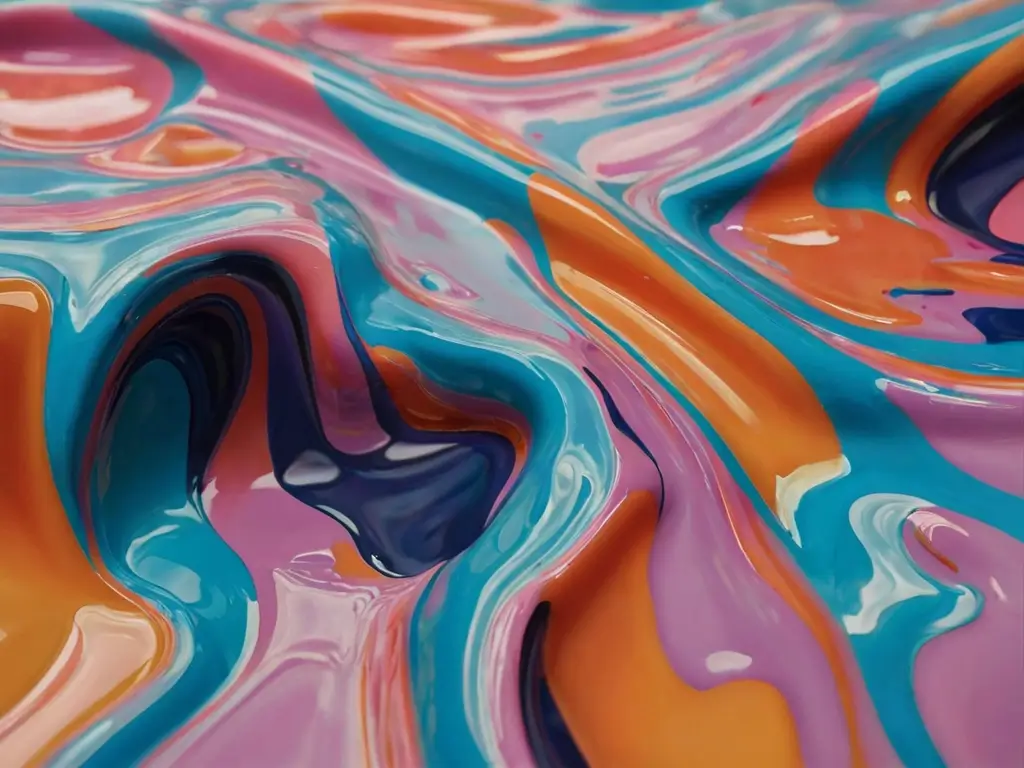Acrylic paint can transform dull, faded plastic into vibrant works of art. With proper preparation and technique, acrylics adhere exceptionally well to plastic for a durable and lasting finish.

Preparing Plastic Surfaces for Painting
Any plastic surface must be cleaned and lightly abraded to achieve the best paint adhesion. Follow these key preparation steps:
Cleaning
Remove all dirt, grease, dust and other contaminants by washing the plastic with mild soap and water. For smoother plastics, isopropyl alcohol can help eliminate any oily residues. Be sure to rinse thoroughly and allow to fully dry.
For plastic parts removed from a vehicle, use a degreaser designed for auto surfaces to cut through built-up grime. Power washing can also help restore exterior plastic trim pieces to a clean, paint-ready state.
Light Sanding
After cleaning, use 220 grit or finer sandpaper to lightly scuff the surface. This abrading action creates microscopic scratches that give the paint something to grip onto. Try a sanding sponge for contoured pieces.
Be careful not to overly scuff smooth plastics – the goal is just to rough up the glossiness, not remove material. Wipe away any sanding residue before painting.
Tack Cloth
Finally, wipe the sanded plastic with a tack cloth – a cloth material with a slightly sticky coating – to pick up any remaining dust or particles. The plastic is now prepped and ready for primer.
Priming Plastic for the Best Acrylic Adhesion
Primer is mandatory for painting plastic with acrylics. Follow these tips for optimal primer selection and application:
Choose the Right Plastic Primer
Look for a primer specifically designed for plastic, such as Krylon Fusion or Rust-Oleum Automotive plastic primer. The formula contains ingredients to maximize adhesion on slick plastic surfaces that standard primers can’t grasp well.
Spray primer provides the easiest, most uniform coverage of complex plastic part shapes. For flat plastic sheets, brush-on liquid primer works too.
Apply in Thin Coats
Mist on two or three thin coats of plastic primer, allowing proper drying time between each. Thick coats are more likely to pool and lead to drips or runs. Thin coats dry faster as well.
Follow the Overspray Rule
When using spray primer, hold the can 6 to 8 inches from the surface and apply light coats using a consistent back-and-forth motion. Each stroke should lightly overlap the previous one by about 50% to ensure even coverage.
Allow Proper Curing Time
Primer needs ample time to fully cure and form a strong bond before painting. This is usually at least 24 hours for air-drying primers. The product directions will specify exact drying times.
Once the primer has fully cured, the plastic is ready for the color acrylic paint topcoat.
Selecting the Best Acrylic Paints for Plastic
With primer in place, it’s time to consider the acrylic paint options. Here are smart guidelines for choosing acrylics to ensure paint success:
Check the Label for Plastic Suitability
Some acrylic paints are specially formulated for use on non-porous surfaces like plastic. The label may indicate “adheres to plastic” or “plastic-compatible”. These are ideal choices.
Opt for Acrylic Craft Paint
Thicker, high-pigment acrylic craft paints grip and cover better than thin acrylic artist colors. Liquitex Basics and FolkArt are good brands for plastic painting.
Consider Spray Paint for Plastic
Aerosol spray paint designed specifically for plastic, like Krylon Fusion, provides great coverage with a quick spray application. Just be sure to use light coats.
Acrylic Enamel Paint
This specialized acrylic paint contains extra binders for maximum adhesion and a super durable finish. It’s excellent for outdoor plastic surfaces. Rust-Oleum makes several acrylic enamel options.
Avoid Vinyl or Latex Wall Paints
Paint + primer in one vinyl or latex wall paints are not formulated for slick plastic and may chip or peel quickly despite the claims. Stick to true acrylic craft paints.
Application Tips for Painting Plastic with Acrylics
Follow these guidelines when applying acrylic paint to primed plastic for flawless results:
Use Synthetic Brushes
Nylon or polyester bristle brushes are best for smooth acrylic painting. The bristles won’t absorb water and go limp like natural hair brushes. This allows better control of the acrylic paint.
Thin With Water or Medium
Thinning acrylic paint with a little water – roughly 10% – makes the consistency easier to control when brush painting. Acrylic mediums can also be used to thin and extend drying time.
Apply With a Soft Touch
A light touch is key, especially on smoothed plastics. Pressing too hard causes brush strokes to cling and pull up, ruining the paint’s adhesion. Gentle, even strokes provide the best coating.
Use Multiple Thin Layers
Applying several thin layers ensures even coverage and avoids drips or brush marks. Thick single coats are prone to cracking and peeling over time. Allow each layer to fully dry between applications.
Spray Paint in Light Sweeps
When using spray paint, keep the can moving at all times while spraying back and forth to prevent drips and runs. Apply 2-3 thin coats for complete coverage, allowing proper drying time between coats.
Inspect for Full Coverage
Examine the painted piece from all angles in good lighting after each coat, touching up any thin spots as needed. This ensures complete coverage and uniformity.
By prepping, priming, and painting plastic properly with high quality acrylic paint, the finish will look amazing and last for many years to come.
Clear Topcoat Options for Protection
A clear acrylic topcoat adds shine while also protecting the painted plastic finish. Consider these options:
Acrylic Spray
Acrylic clear coat spray paint, like Krylon Crystal Clear, provides quick and even coverage. Multiple thin coats maximize protection and create a smooth surface.
Brush-On Acrylic Varnish
For a higher gloss finish, brush on an acrylic varnish like Liquitex Gloss Varnish. Use thin layers and a soft brush to prevent streaks and bubbles.
Polyurethane
Oil-based polyurethane forms a super protective barrier that smoothes the painted finish. Use sparingly thinned with mineral spirits and allow ample drying time between coats.
Epoxy Resin
For heavy use plastic items, pouring on a layer of clear epoxy resin creates a thick, glass-like finish. Superglue brand makes several plastic-safe epoxy resin options.
Painting Different Types of Plastic
The specific plastic material impacts preparation needs and paint adhesion. Here’s how to address the most common types:
ABS Plastic
ABS (acrylonitrile butadiene styrene) plastic is commonly used for pipes, automotive trim and small appliances. Its slick surface requires extra prep sanding to achieve paint adhesion. Adhesion-promoting primer is a must.
PVC Plastic
Polyvinyl chloride, or PVC, is found in plumbing parts, window frames, toys and more. It can be challenging for paints to bond to and may require etching or chemical treatment for grip. Specialized spray paint works best.
Polyethylene Plastic
Polyethylene plastics include plastic bags, shampoo bottles and plastic furniture. Acrylic craft paints with added binders or spray paints formulated for plastic work well on this flexible material.
Polypropylene Plastic
Durable polypropylene is used in food containers, auto parts and outdoor furniture. Proper sanding and plastic-specific primer allow acrylic paints to adhere well to this semi-flexible plastic.
Polystyrene Plastic
Polystyrene plastic includes plastic cups, packaging materials and disposable cutlery. Extra sanding helps paint grip better. Acrylic craft paint offers good coverage and flexibility.
Polycarbonate Plastic
Nearly unbreakable polycarbonate is found in eyeglasses, safety goggles and machine covers. For paint adhesion, it must be thoroughly sanded and primed with a coating designed for polycarbonates.
Fiberglass
Fiberglass has a porous surface that readily accepts paint, but acrylic primers still provide an extra bonding layer. Acrylic enamels work well for a long-lasting finish.
Painting Interior vs. Exterior Plastic Parts
Plastic surfaces used indoors versus outdoors have slightly different painting requirements:
Interior Plastic Painting
Indoors, nearly any acrylic paint can be used since durability is less crucial. Focus on colors, sheens and techniques to match the décor. Matte or satin finishes prevent unwanted shine.
Exterior Plastic Painting
For outdoor plastics, specialized durable acrylics or acrylic enamels are a must. Opt for weather-resistant, UV-stable colors. Gloss or semi-gloss clears protect against rain, dirt and sun damage.
Proper surface prep and priming are even more critical before painting exterior plastics to prevent peeling and premature paint failure.
Painting Techniques for Creative Effects
Beyond basic application, acrylics lend themselves to endless creative techniques on plastic:
Color Blending
Wet blending with a damp brush creates soft, blended color gradients. Allow colors to slightly dry before blending for bolder definition.
Faux Finishes
Use sponges, rags, stippling and graining tools to achieve unique faux finishes like woodgrain, marble, patina or distressed effects.
Masking
Mask off sections with tape or stencils for sharp paint lines, geometric patterns, stripes and more. Remove masking immediately after painting.
Crackle Effect
Apply a crackle medium over dried paint, then top with a contrasting color. As the base layer dries, it cracks to reveal the lower color.
Metallic Finishes
Incorporate aluminum, gold, copper or bronze acrylic paints for eye-catching metallic plastic. Or mix metallic powder or leaf into clear acrylic medium.
With the right acrylic products and techniques, plastic becomes the perfect versatile canvas for all types of artistic, decorative finishes.

